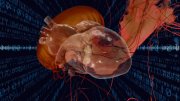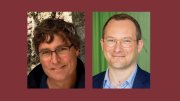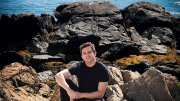With speeches and feasting, Harvard celebrated the launch of its new School of Engineering and Applied Sciences (SEAS) on September 20. During a luncheon ceremony on the lawn outside Pierce Hall, President Drew Faust signaled for the unfurling of banners bearing the school’s new seal. Two former presidents of the Board of Overseers spoke: Thomas E. Everhart ’53, former president of the California Institute of Technology and professor of electrical engineering and applied physics emeritus, traced contemporary engineering at Harvard back to “the vision of James Bryant Conant”; Susan Graham ’64, Chen Distinguished Professor of electrical engineering and computer science emerita at the University of California, Berkeley, stressed the importance of “intellectual linkages” between the engineering faculty and “virtually every other part of the campus.” As SEAS dean Venkatesh Narayanamurti explained in his remarks, the change in status for the former Division of Engineering and Applied Sciences “reflects the fact that these disciplines now influence almost all aspects of human endeavour—from advancing knowledge, to meeting human needs, to advancing prosperity, to ensuring sustainability.”

Photograph by Justin Ide/Harvard News Office
President Faust and SEAS dean Narayanamurti launched a bridge-building new school.
During a decade of leadership under Dean Venky, as he is known, the school’s faculty has grown about 50 percent, now numbering near 70, and is expected to grow as much again in coming years (see “Quantum Leap for Engineering,” July-August 2006, page 63). The number of graduate-student applicants has tripled, allowing the program to become more selective even as the number of enrolled students more than doubled.
This is not the first ascendance of applied science at the University. In 1847, Harvard created the Lawrence Scientific School (funded in part by industrialist Abbott Lawrence) in response to the mid-nineteenth-century’s growing industrial economy; it provided a technological education that could be applied to the “useful arts.” But in 1906, President Charles William Eliot—uneasy with the “practical” bent of the school despite his own training in chemistry—disassembled it.
“In the century since,” Faust recounted at the inaugural ceremonies, “the organizational saga of Harvard engineering has had more twists than a Möbius strip. But like a Möbius strip, it has come full circle.” She then catalogued the various incarnations of Harvard engineering since Eliot’s day—“The historian in me can’t resist,” she confessed—remarking that “through it all, Harvard’s engineering and technology enterprise, whatever people have cared to call it at any given moment, continued to make remarkable contributions to the world of useful scientific knowledge.”

Photograph by Tom Fitzsimmons
Flags bearing the seal of the new School of Engineering and Applied Sciences adorned centerpieces at the luncheon that celebrated the school’s debut.
Among the many such contributions, Faust noted discoveries ranging from the crystal oscillator that enabled radio and television to nuclear magnetic resonance, now the basis for modern medical imaging. She also stressed applied science’s “power to connect, to bridge, and therefore to enliven and strengthen a great many other parts of the University….”
These aspects of the school’s role—one looking outward toward society, the other an intra-institutional means of linking disciplines, departments, and schools—formed the basis of two afternoon symposiums in Sanders Theatre.
Keynote speaker Charles Vest, president of the National Academy of Engineering, and former president of MIT, articulated the overarching theme of the afternoon: that “research universities are a critical part of the framework that drives innovation and produces economic and social good in America and throughout the world.” Vest cited computing, the laser, the Internet, financial engineering, the genetic revolution, the vast majority of modern medicines, and others as examples of discoveries that originated in universities.
H. Vincent Poor, dean of Princeton’s School of Engineering and Applied Science, and his MIT counterpart, Subra Suresh, dean of the school of engineering, were part of a panel on “Bridging Disciplines: The Role of Engineering and Applied Sciences in Tomorrow’s University.” Poor stressed that “engineering is about solving societal problems” (such as finding “an energy technology that allows us to run our economy without destroying the environment”) “through applications of science and technology.” Technology has become so pervasive that “it won’t be possible in the twenty-first century to be a great liberal arts university without having a great school of engineering. This is the statement,” he said, “that I think Harvard is making today.”
Suresh agreed, but noted a disturbing counter-trend. “Over the last 10 or 12 years,” he said, “there has been 6 percent decline in enrollment in engineering—that is, at a time when technology has become [more important] in our lives.” He blames this, in part, on “a lack of clear vision at the national level.” Invoking past American strategic investments, such as the federal highway system and the Marshall Plan, he asked, “Are we directing our resources in the right direction?” The challenge, both panelists agreed, is to ensure that engineers are broadly educated and that all students understand something about the role technology plays in society.
Panel moderator Michael Smith, Gordon McKay professor of computer science and dean of the Faculty of Arts and Sciences (of which the new school remains a part), noted that Harvard students are already pushing in this direction: “Students are coming to us in engineering with an interest not just in ‘How does this work?’ but ‘How does this work in the world?’”
A second panel addressed “Engineering and Applied Sciences in the Wider World: Solving Societal Problems.” Former Harvard provost Harvey V. Fineberg, now president of the Institute of Medicine, emphasized that engineering matters to public health and medicine “not only because of what it does...but because of the way of thinking that is embedded in an engineering education.” Such thinking, for example, can save lives by reducing hospital medical errors. “The key to safety and improved quality is through systems thinking,” he said. “That is the profound contribution of engineering.”
Paul M. Horn, senior vice president and director of research at IBM, argued that the nature of innovation is changing: businesses now cite partners, rather than their own research and development departments, as their greatest source of new ideas. IBM, he noted, coordinates the delivery of products supplied by an ecosystem of partners—the company gives its patents away as part of these relationships. He urged universities to “think differently about intellectual property.”
Last to speak was John Holdren, Heinz professor of environmental policy, director of the Program on Science, Technology, and Public Policy at the Kennedy School of Government, and chair of the American Association for the Advancement of Science. A polymath whom Dean Narayanamurti called “in many ways, the essence of what we want to do here,” Holdren focused on the concept of sustainability. Technological advances, he hopes, will allow societies to convert “the maintenance and further improvement of human well-being” to a “sustainable basis.” Finding renewable sources of energy is fundamental to that goal. He cited Harvard’s depth and breadth not only in the sciences but in business, design, health, and government as “tremendously powerful” resources that could be enlisted in this critical quest.
Three hours later, at the celebratory closing dinner, Narayanamurti summed up SEAS’s debut with characteristic enthusiasm: “Today has proven to me, beyond any doubt, that you are never too old to be excited by the first day of school.”








